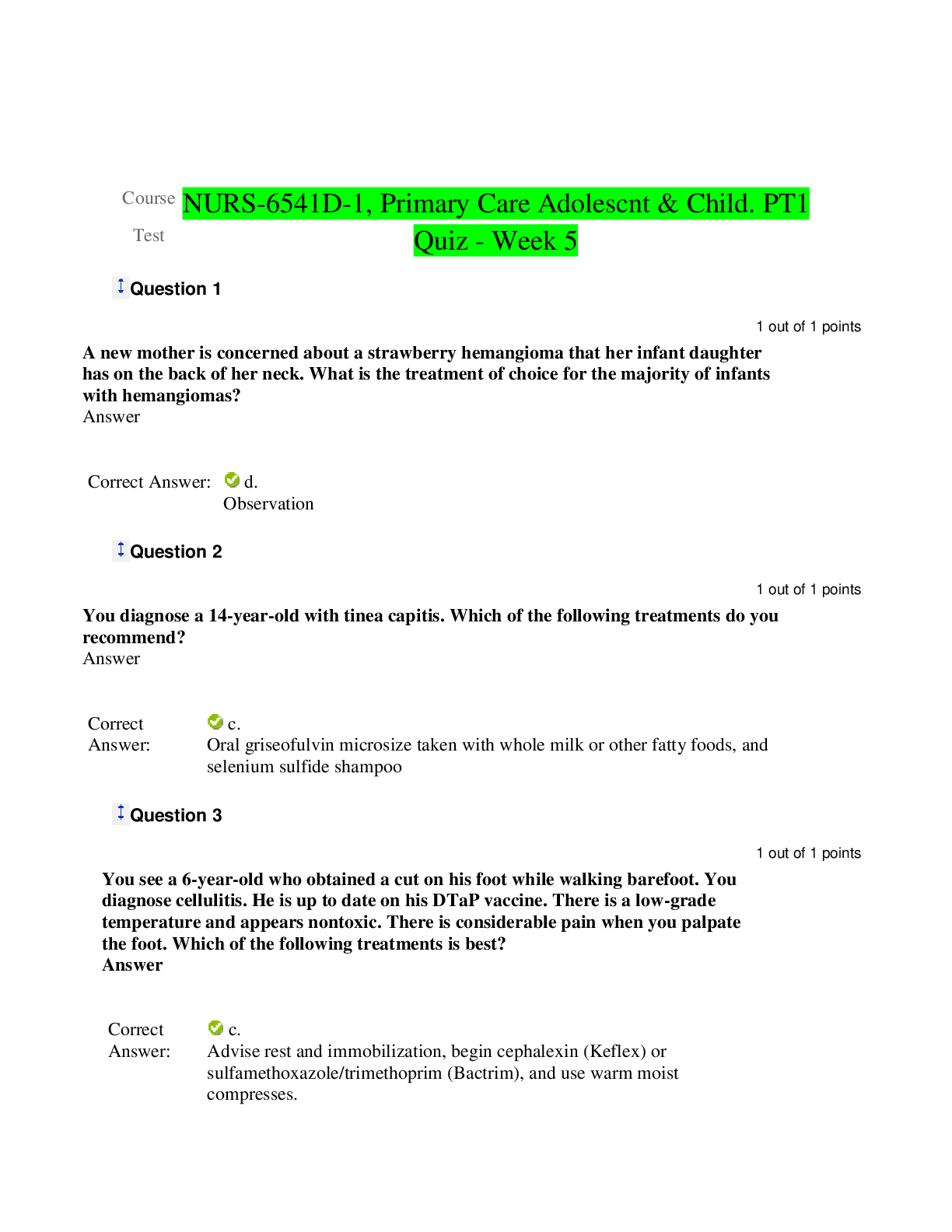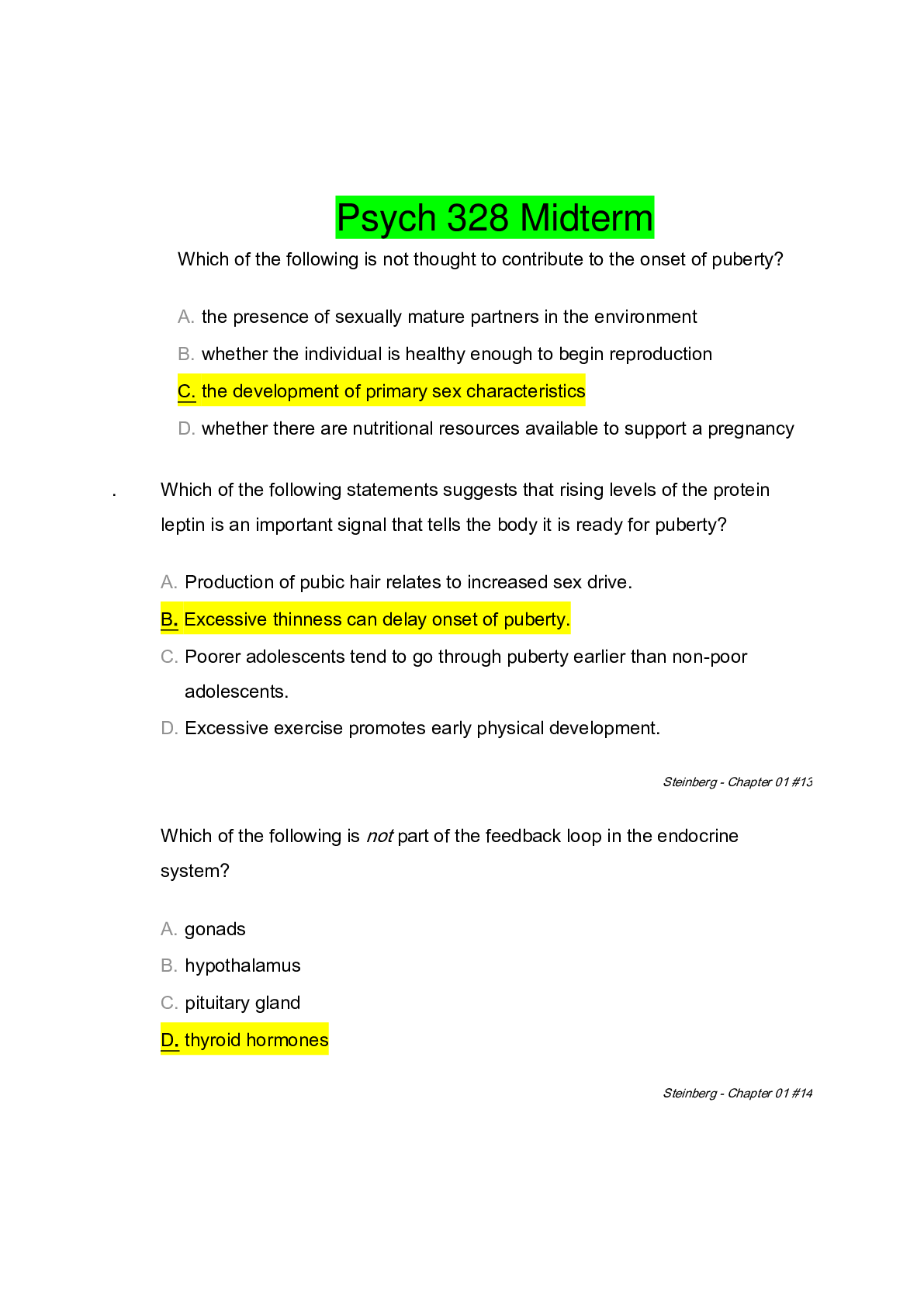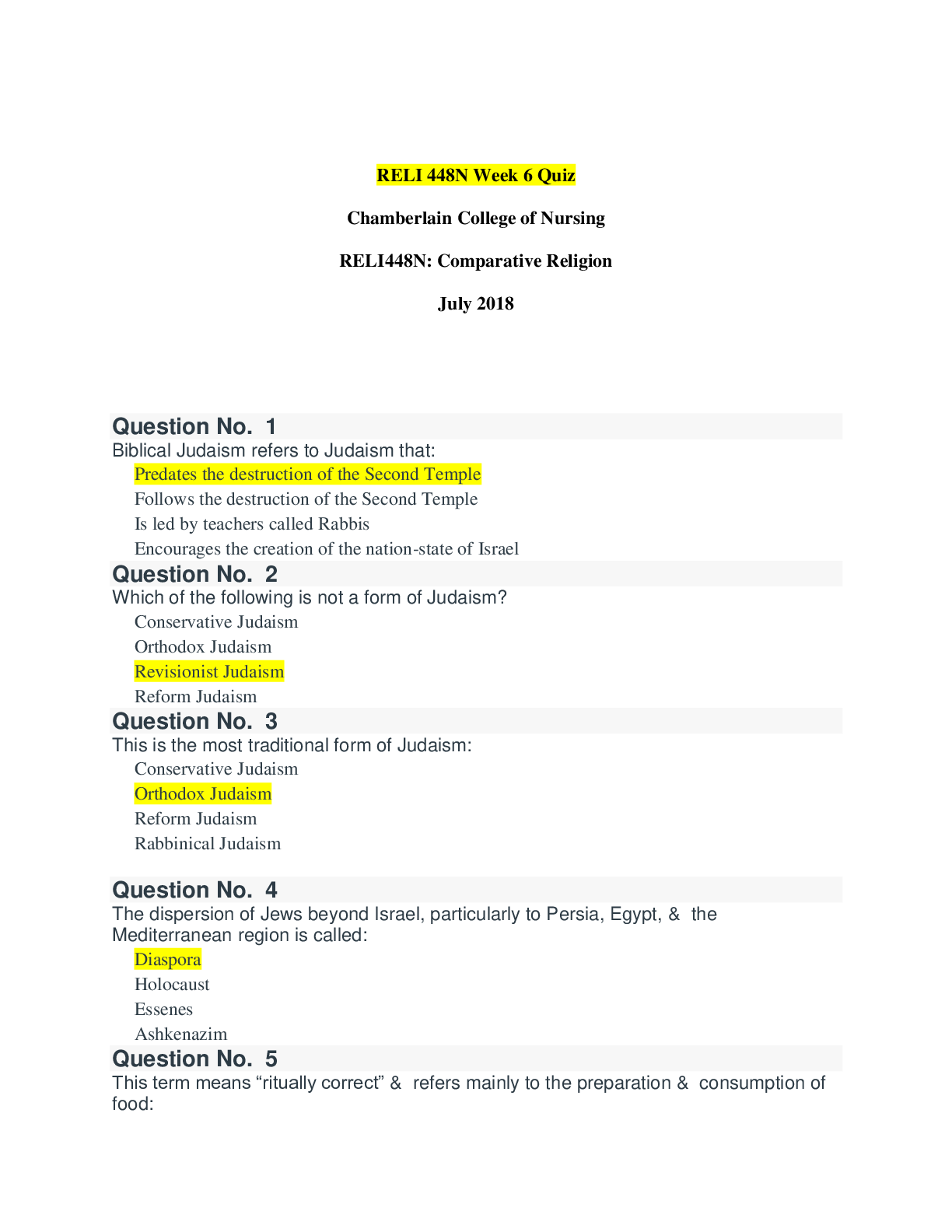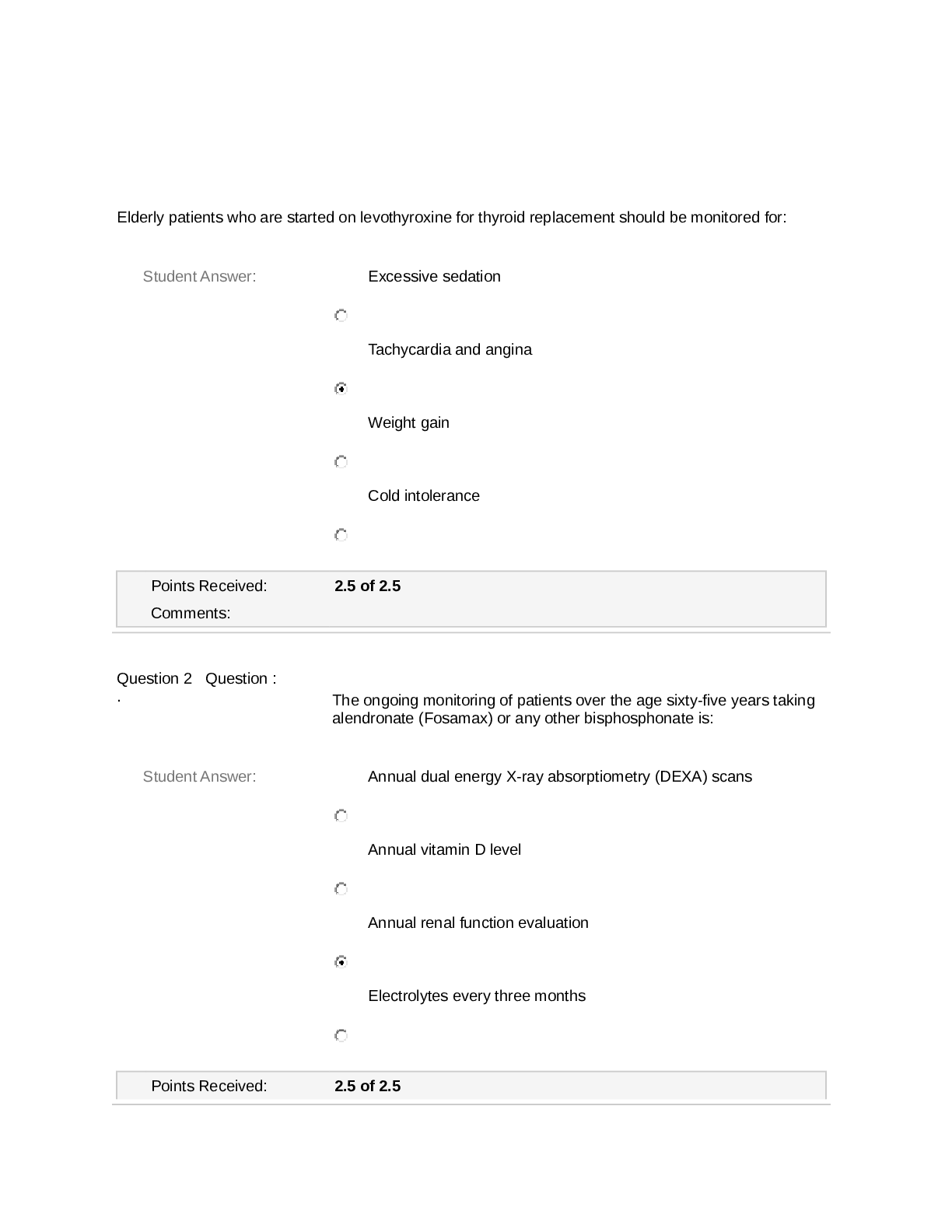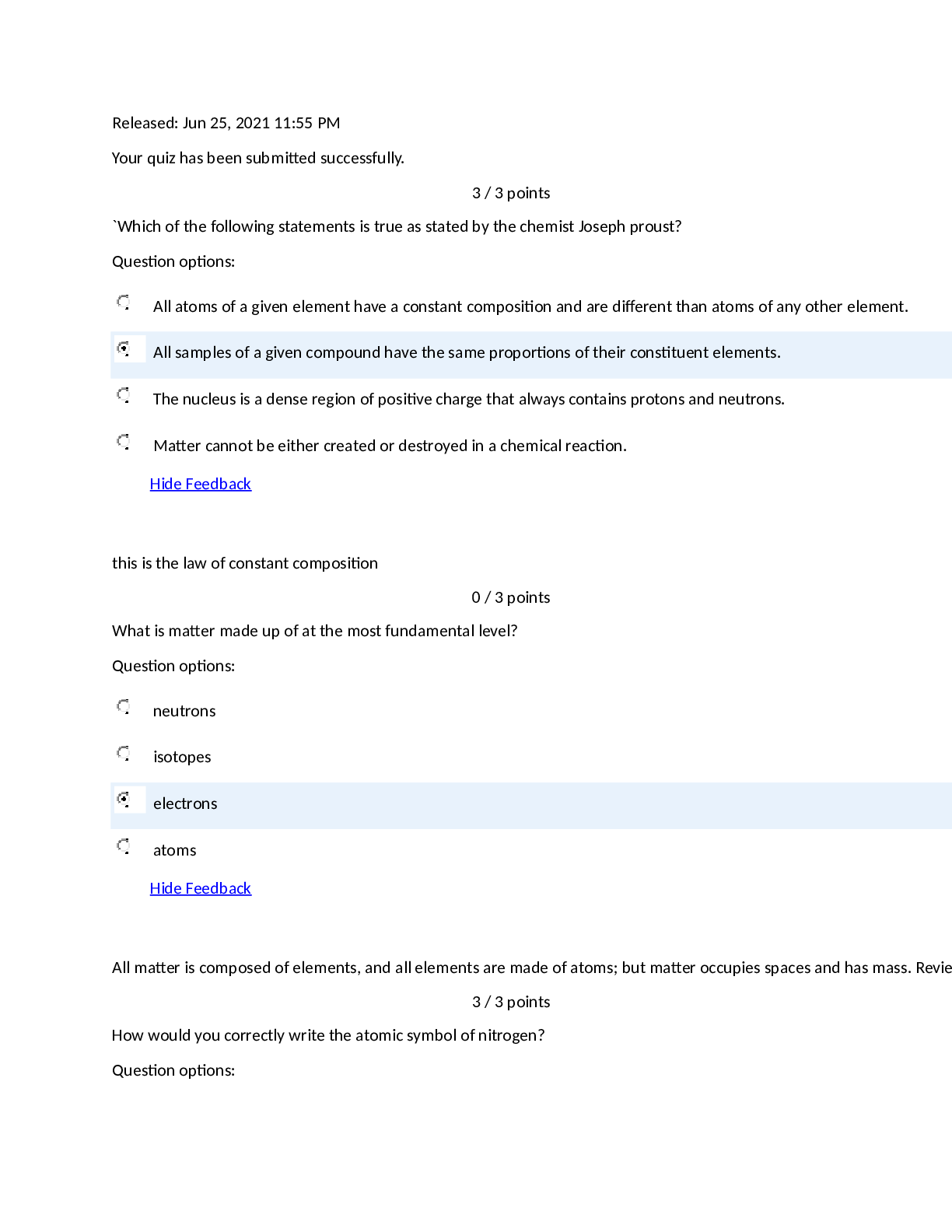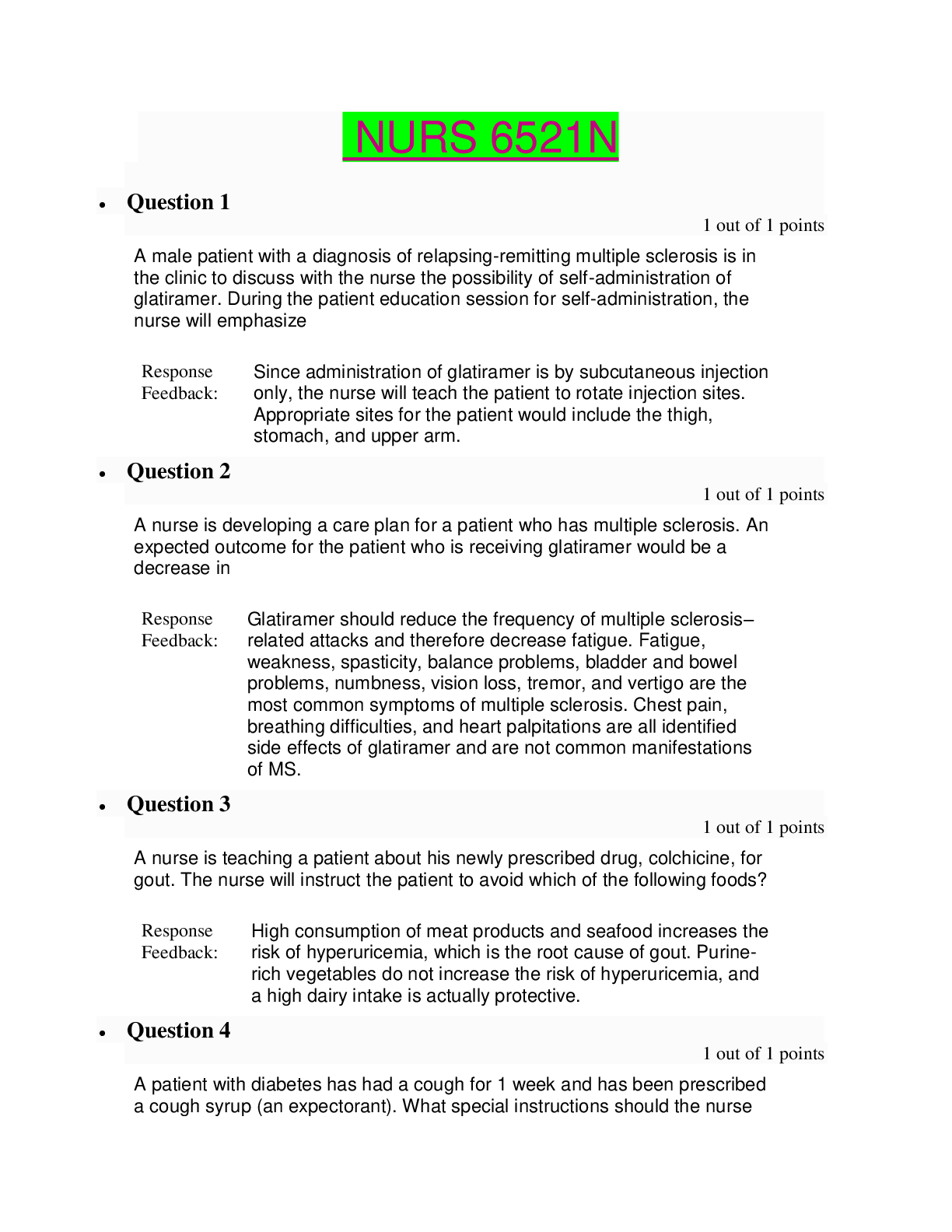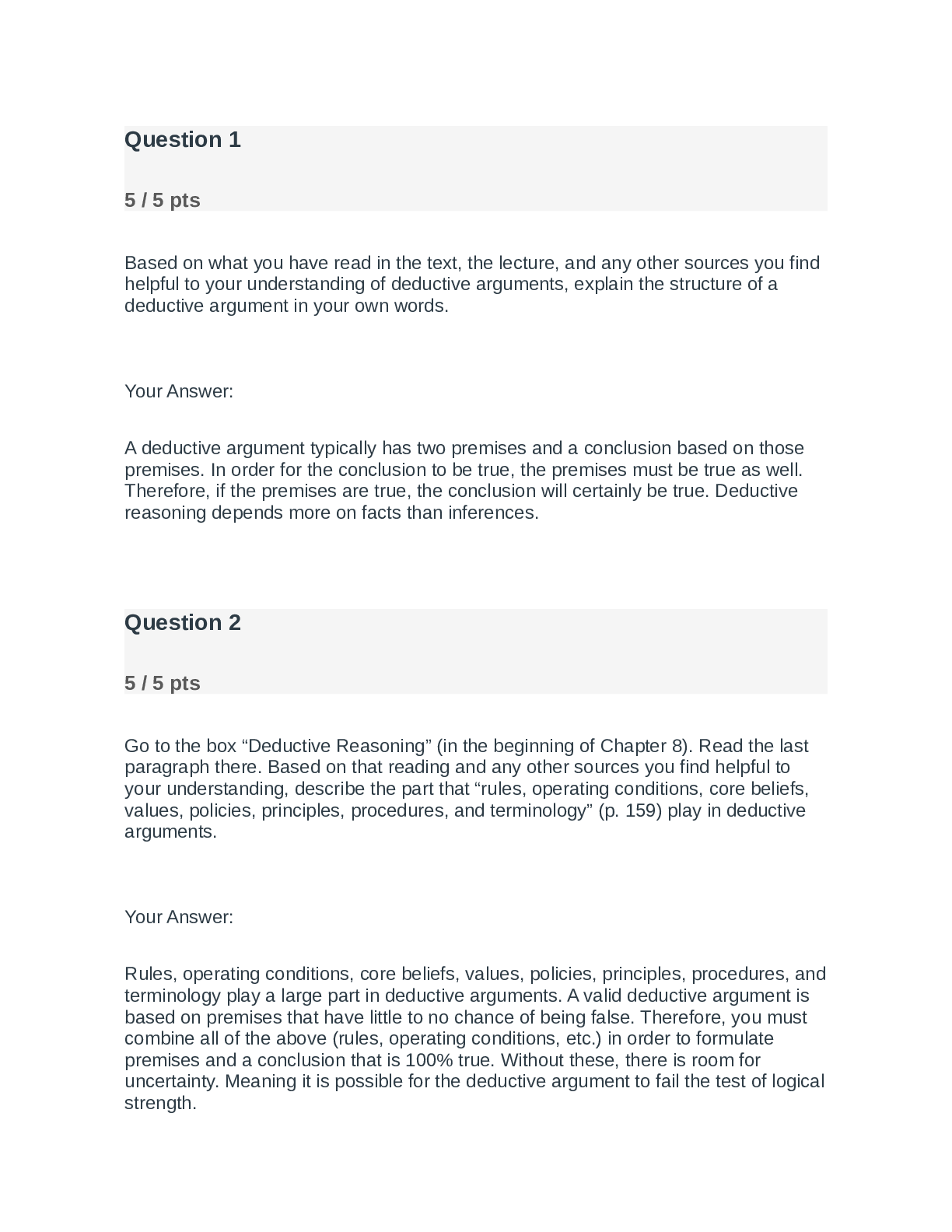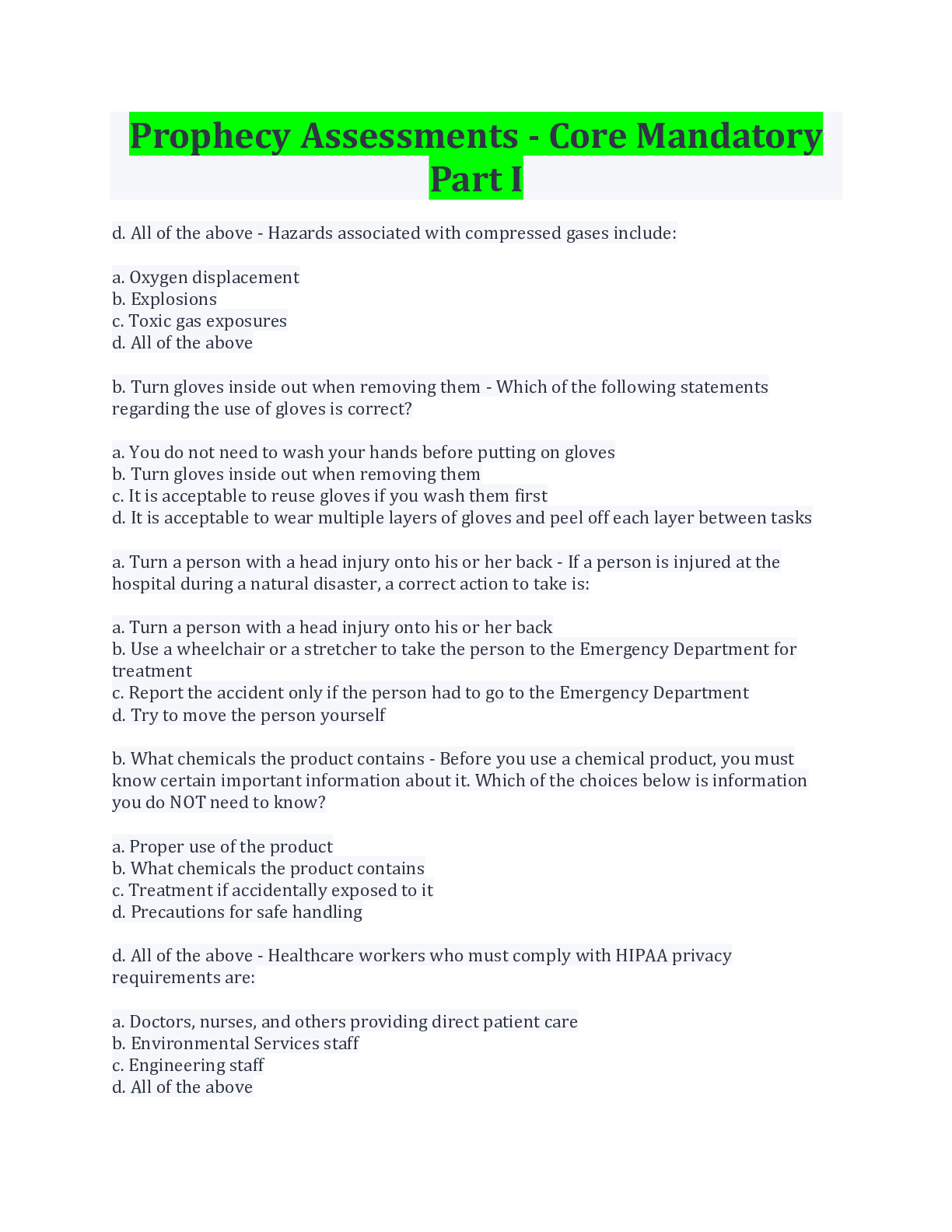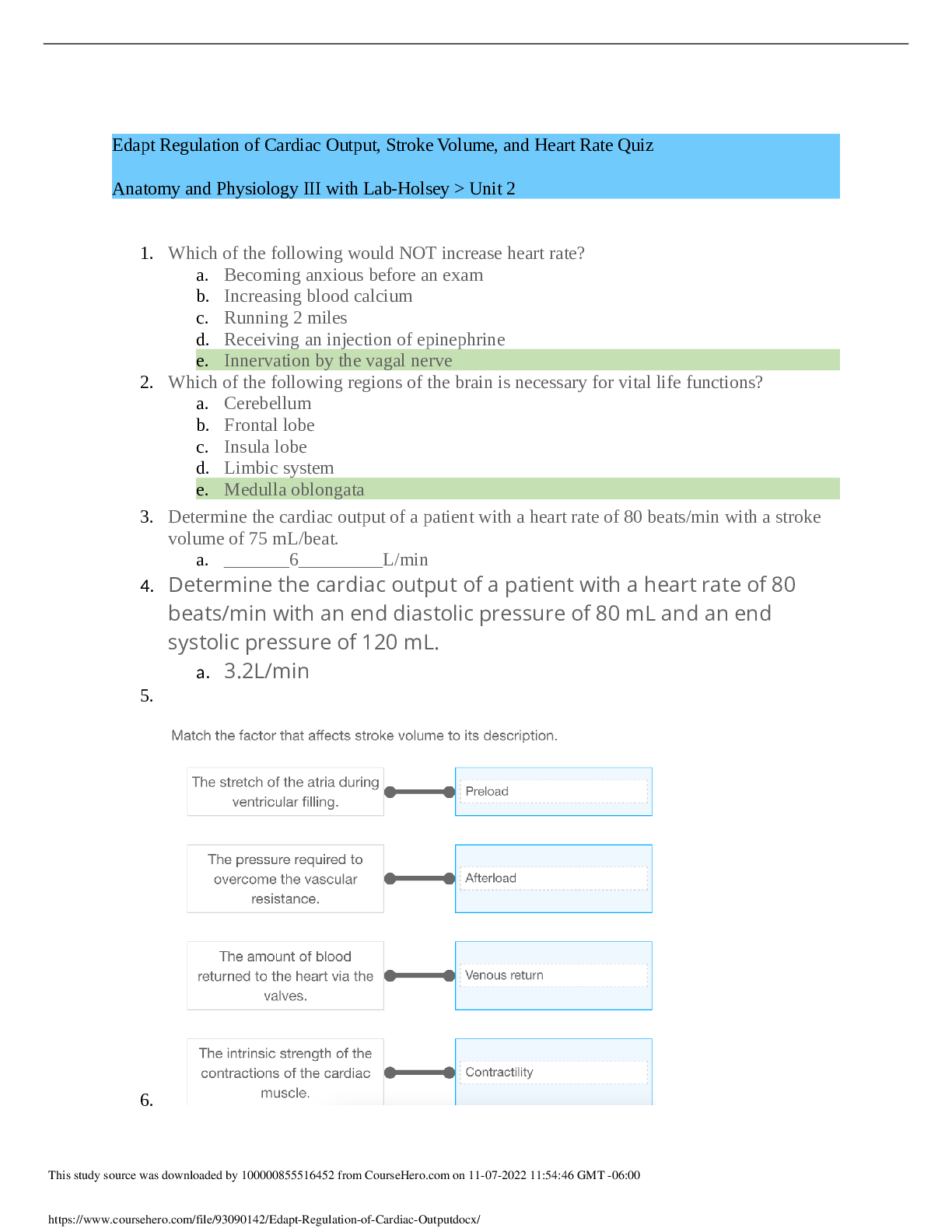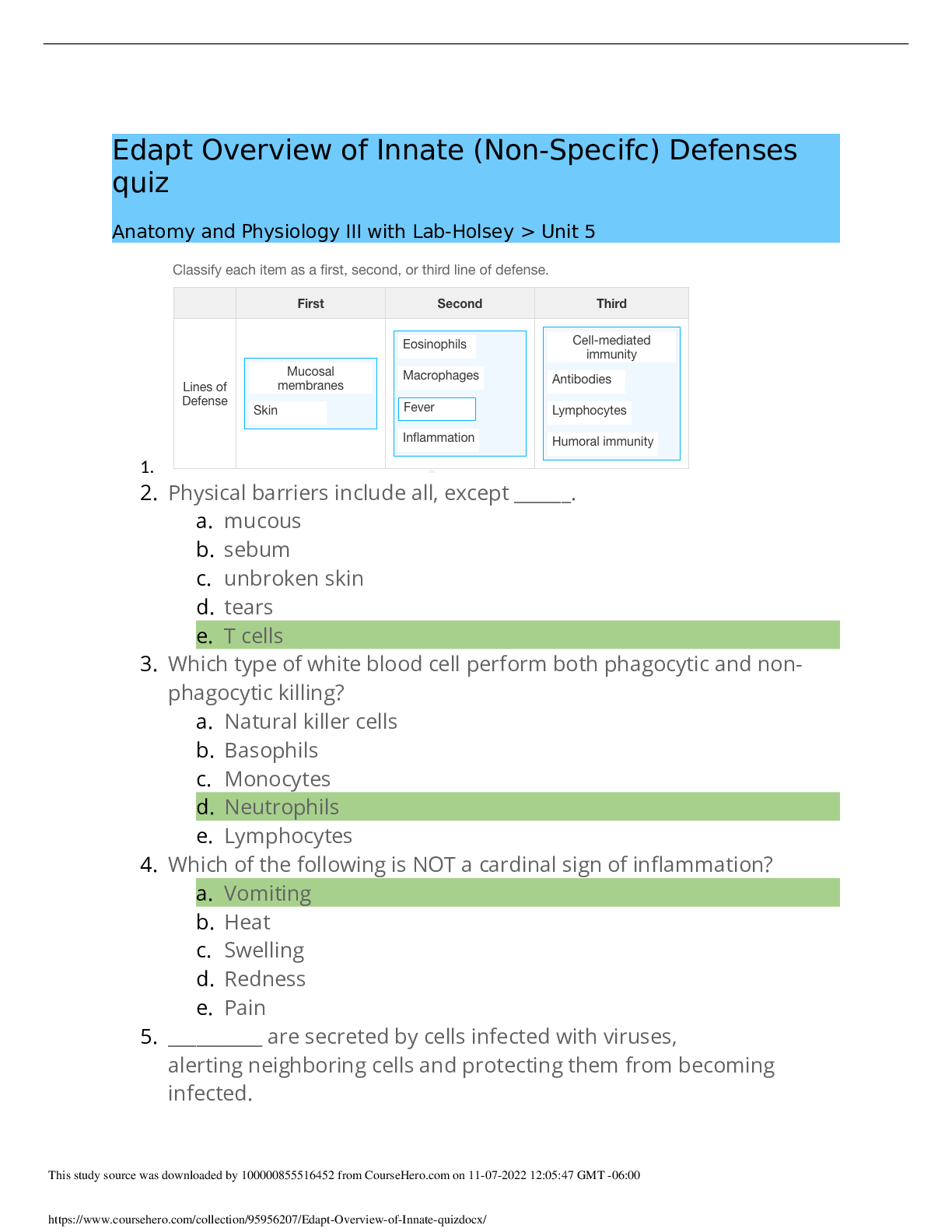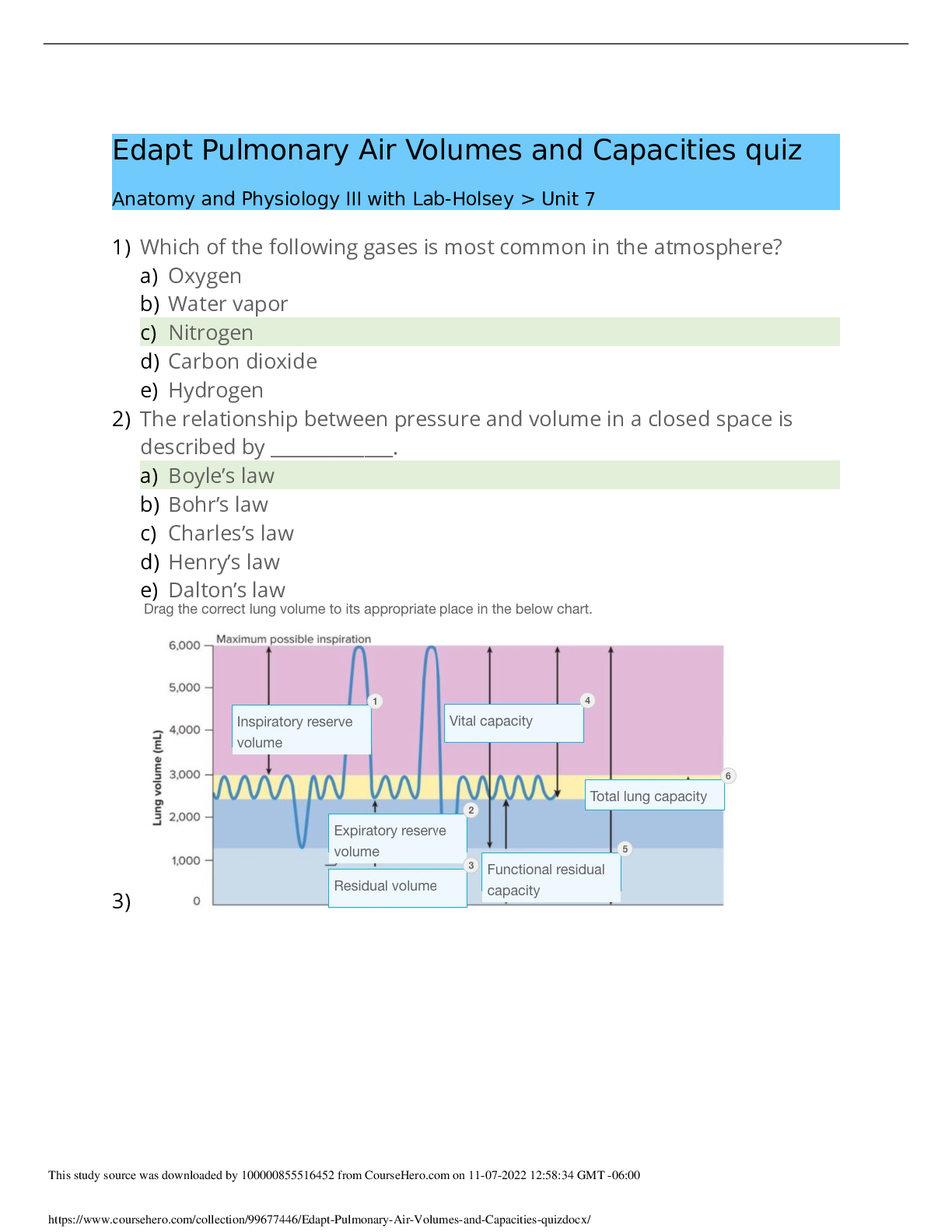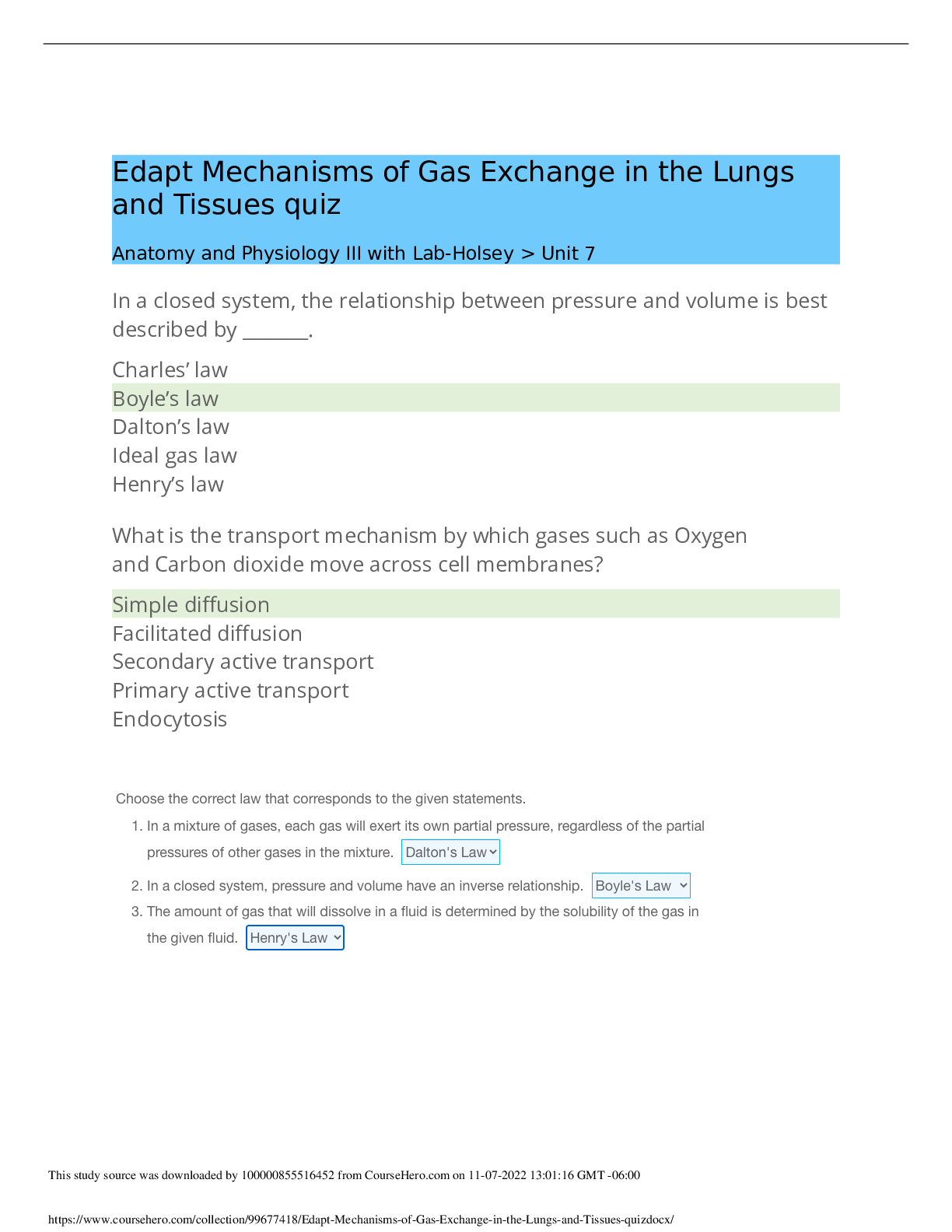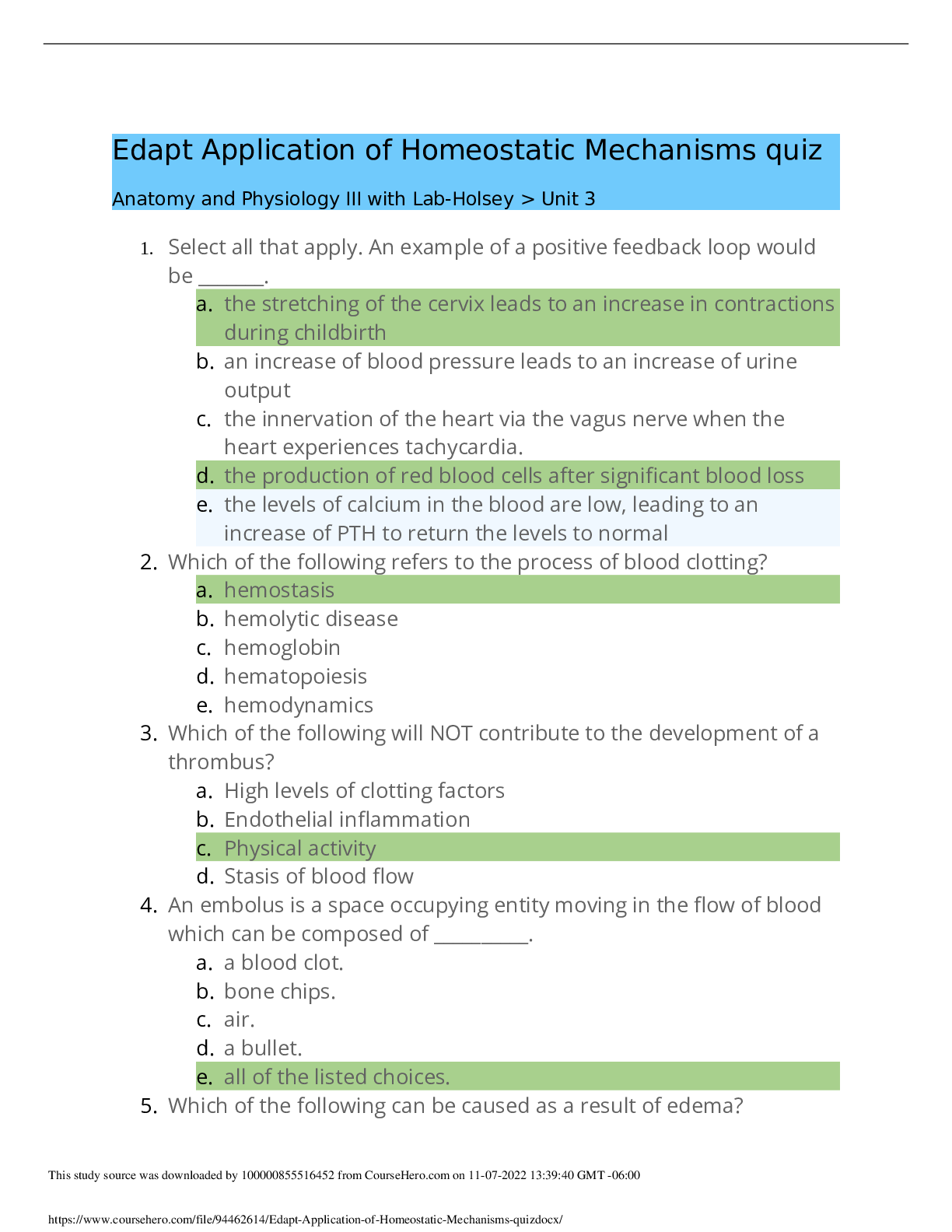*NURSING > QUESTIONS & ANSWERS > South University > Nursing 6101 > RESEARCH NSG 6101 chapter 9 quiz (GRADED A) (All)
South University > Nursing 6101 > RESEARCH NSG 6101 chapter 9 quiz (GRADED A)
Document Content and Description Below
Question 1. Question : A criterion for a diagnosis of generalized anxiety disorder (GAD) is a period of excessive worrying that lasts for at least how many months? 3 6 9 ... 12 : GAD is diagnosed when an individual spends at least 6 months worrying excessively and exhibits at least three of the six symptoms. Although 3 months is not sufficient time, the remaining options are excessive. Question 2. The existence of regular, deep, and rapid respirations after a severe closed-head injury is indicative of neurologic injury to the: Lower midbrain Pontine area Supratentorial tissues Cerebral area Central reflex hyperpnea, which is a sustained deep and rapid but regular respiratory pattern that is the result of CNS damage or disease, involves the lower midbrain and upper pons. This neurologic injury is observed after increased ICP and blunt head trauma. Damage to any of the other areas listed would not produce this breathing pattern. Question 3. Which term is used to describe a hernial protrusion of a saclike cyst that contains meninges, spinal fluid, and a portion of the spinal cord through a defect in the posterior arch of a vertebra? Encephalocele Meningocele Spina bifida occulta Myelomeningocele Myelomeningocele is a hernial protrusion of a saclike cyst containing meninges, spinal fluid, and a portion of the spinal cord with its nerves through a defect in the posterior arch of a vertebra. The remaining options are not appropriate terms to identity the described condition. Question 4. Which term is used to describe a complication that can result from a spinal cord injury above T6 that is producing paroxysmal hypertension, as well as piloerection and sweating above the spinal cord lesion? Craniosacral dysreflexia Parasympathetic dysreflexia Autonomic hyperreflexia Retrograde hyperreflexia Individuals most likely to be affected have lesions at the T6 level or above. Paroxysmal hypertension (up to 300 mm Hg systolic), a pounding headache, blurred vision, sweating above the level of the lesion with flushing of the skin, nasal congestion, nausea, piloerection caused by pilomotor spasm, and bradycardia (30 to 40 beats/minute) characterize autonomic hyperreflexia. No other options appropriately describe this complication. Question 5. With receptive dysphasia (fluent), the individual is able to: Respond in writing but not in speech. Produce verbal speech but not comprehend language. Comprehend speech but not verbally respond. Neither respond verbally nor comprehend speech. The individual experiencing receptive dysphasia may be able to produce verbal language, but language is meaningless because of a disturbance in understanding all language. The remaining options do not describe receptive dysphasia. Question 6. Dilation of the ipsilateral pupil, following uncal herniation, is the result of pressure on which cranial nerve (CN)? Optic (CN I) Abducens (CN VI) Oculomotor (CN III) Trochlear (CN IV) The oculomotor CN (III) is involved in this manifestation of pupil dilation. None of the other options would result in pupil dilation when subjected to pressure. Question 7. The neural groove closes dorsally during which week of gestational life? Second Fourth Eighth Twelfth During the fourth gestational week, the neural groove deepens, its folds develop laterally, and it closes dorsally to form the neural tube, epithelial tissue that ultimately becomes the CNS. The second week is too early, and the other options represent times periods after the groove closes. Question 8. Which type of seizure starts in the fingers and progressively spreads up the arm and extends to the leg? Complex psychomotor seizure Focal (partial) Jacksonian seizure Generalized seizure Atonic/drop seizure Focal (partial) Jacksonian seizures most often begin in the face and fingers and then progressively spread to other body parts. The other options do not begin and spread in the fashion described. Question 9. A right hemisphere embolic cerebrovascular accident (CVA) has resulted in left-sided paralysis and reduced sensation of the left foot and leg. Which cerebral artery is most likely affected by the emboli? Middle cerebral Vertebral Posterior cerebral Anterior cerebral Symptoms of an embolic stroke in only the right anterior cerebral artery would include left-sided contralateral paralysis or paresis (greater in the foot and thigh) and mild upper extremity weakness with mild contralateral lower extremity sensory deficiency with loss of vibratory and/or position sense and loss of two-point discrimination. Question 10. The link between major depression and cortisol secretion is that individuals with depression: Show suppression of plasma cortisol when given dexamethasone. Have a decreased plasma cortisol level, despite the administration of exogenous corticosteroids. Show that persistently elevated plasma cortisol levels can result in inflammation that is believed to trigger depression. Have normal plasma cortisol levels throughout the day when they take antidepressant medication, as prescribed. Persistent elevations in cortisol may also induce immunosuppression that compromises the body’s immune systems to contain inflammation and infectious diseases. Increasing evidence suggests that inflammation is another risk factor that triggers the onset of depression. The options related to dexamethasone and exogenous corticosteroids are not true as they apply to depression and cortisol secretion. Question 11. The most likely rationale for body temperature fluctuations after cervical spinal cord injury is that the person has: Developed bilateral pneumonia or a urinary tract infection (UTI) Sustained sympathetic nervous system damage resulting in disturbed thermal control Sustained a head injury that damaged the hypothalamus’s ability to regulate temperature Developed septicemia from posttrauma infection Spinal cord injuries result in disturbed thermal control because the sympathetic nervous system is damaged. None of the remaining options explain this complication. Question 12. Stage 1 intracranial hypertension is caused by the: Loss of autoregulation that normally maintains constant blood flow during changes in cerebral perfusion pressure Displacement of cerebrospinal fluid (CSF), followed by compression of the cerebral venous system Vasoconstriction of the cerebral arterial system with a reciprocal increase in systemic blood pressure Compression of the medulla oblongata in the brainstem by herniation of the cerebral cortex If ICP remains high after CSF displacement out of the cranial vault, then cerebral blood volume is altered, resulting in stage 1 intracranial hypertension. Vasoconstriction and external compression of the venous system occur in an attempt to further decrease the ICP. None of the remaining options accurately describe the cause of stage 1 intracranial hypertension. Question 13. Question : The most common primary CNS tumor is the: Microglioma Neuroblastoma Astrocytoma Neuroma Astrocytomas are the most common primary CNS tumors (50% of all brain and spinal cord tumors). The other options do not occur as frequently. Question 14. The most critical aspect in correctly diagnosing a seizure disorder and establishing its cause is: : Computed tomography (CT) scan Cerebrospinal fluid (CSF) analysis Skull X-ray studies Health history Although the history may be supplemented with the remaining options, it remains the pivotal tool for establishing the cause of a seizure disorder. Question 15. The weakness resulting from the segmental paresis and paralysis characteristic of anterior horn cell injury is difficult to recognize because: Upper motor neurons are involved. The injury is microscopic. Two or more nerve roots supply each muscle. The person is unable to feel the involved muscles. The paresis and paralysis associated with anterior horn cell injury are segmental; however, because two or more roots supply each muscle, the segmental character of the weakness may be difficult to recognize. The reason this pathophysiologic condition is difficult to recognize is not appropriately explained by any of the other options. Question 16. It is true that Guillain–Barré syndrome (GBS): Is preceded by a viral illness Involves a deficit in acetylcholine Results in asymmetric paralysis Is an outcome of human immunodeficiency virus (HIV) GBS is considered to be an autoimmune disease triggered by a preceding bacterial or viral infection. None of the other options are true of GBS. Question 17. Which group is most at risk of spinal cord injury from minor trauma? Children Adolescents Adults Older adults Because of preexisting degenerative vertebral disorders, older adults are particularly at risk for minor trauma, resulting in serious spinal cord injury, especially from falls. The risk to the other age groups is less than that of the older adult. Question 18. Which characteristic is a medical criterion of brain death? Akinetic mutism Coma Apnea Locked-in syndrome Apnea is viewed as a criterion of brainstem death, whereas the remaining options reflect cerebral death. Question 19. Characteristics of primary motor neuron atrophy include: Loss of sensation in distal, proximal, or midline muscles Fasciculations and muscle cramps Flaccid paralysis with paresthesia Spastic paralysis with increased deep tendon reflexes Fasciculations are particularly associated with primary motor neuron injury, and muscle cramps are common. The other options do not describe characteristics of primary motor neuron atrophy. Question 20. Which midbrain dysfunction causes pupils to be pinpoint size and fixed in position? Diencephalon dysfunction Oculomotor cranial nerve (CN) dysfunction Dysfunction of the tectum Pontine dysfunction Pinpoint fixed pupils are a result of pontine dysfunction. The diencephalon, oculomotor cranial nerve, and tectum are not involved in such a pupil reaction. [Show More]
Last updated: 1 year ago
Preview 1 out of 7 pages
Instant download
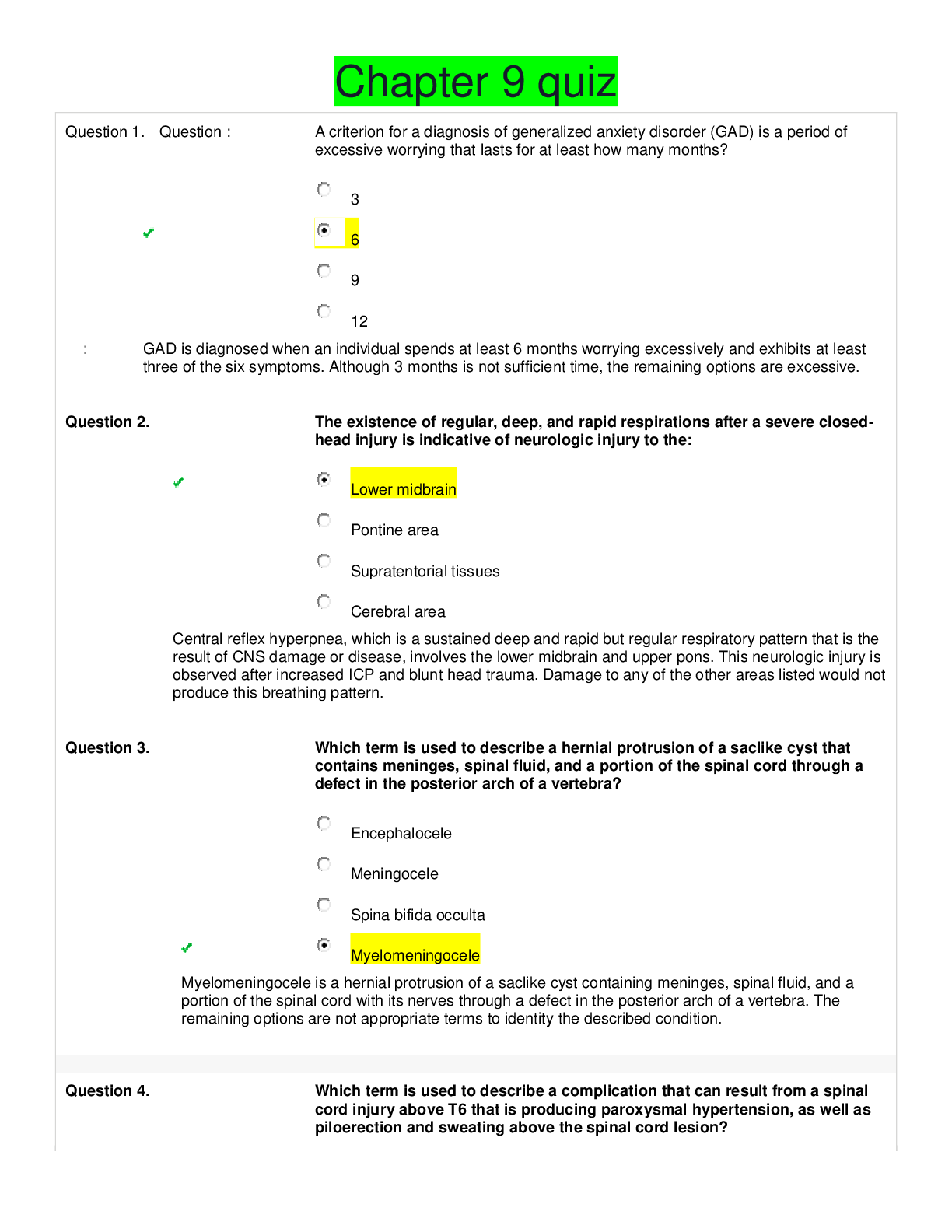
Instant download
Reviews( 0 )
Document information
Connected school, study & course
About the document
Uploaded On
Apr 25, 2020
Number of pages
7
Written in
Additional information
This document has been written for:
Uploaded
Apr 25, 2020
Downloads
0
Views
46













